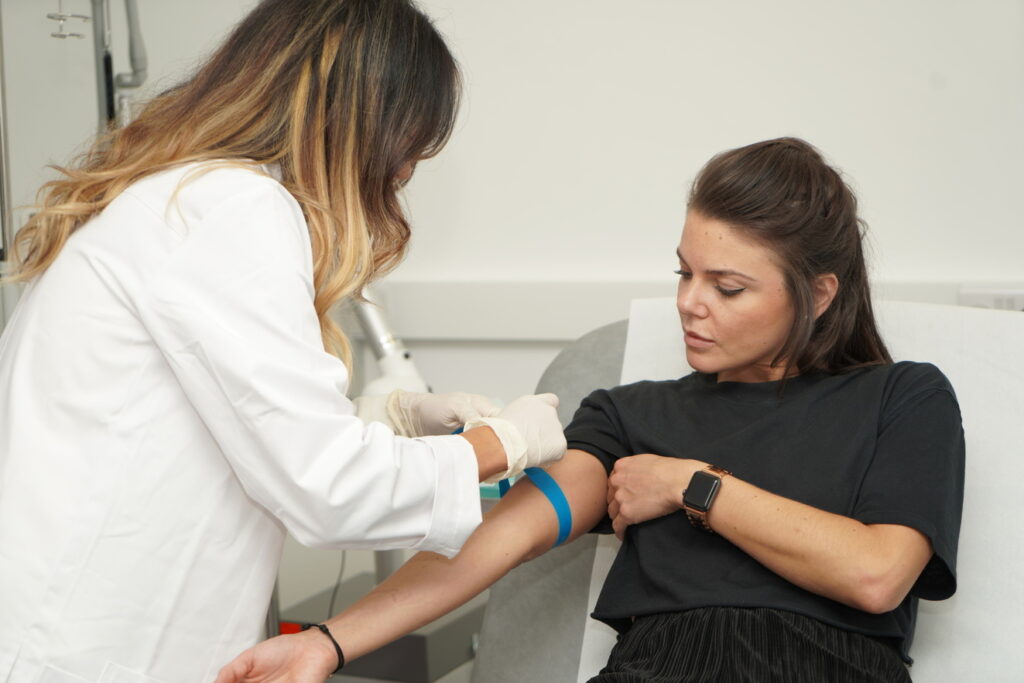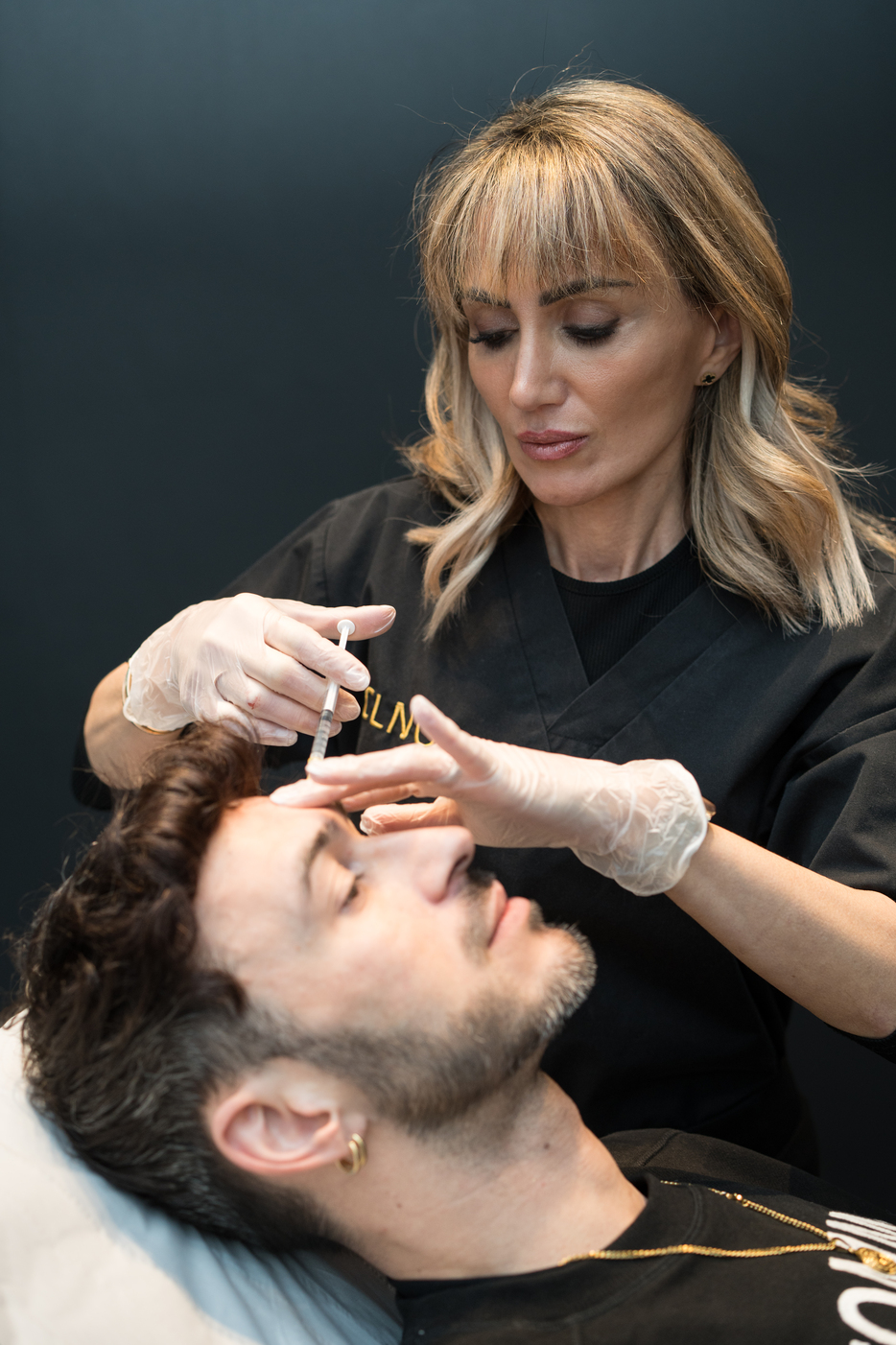Birthmarks
Birthmark Removal Manchester and Cheshire
What Are Birthmarks?
Birthmarks are discoloured or raised marks that appear on the skin either at birth or shortly afterward. They vary greatly in shape, size, and colour, ranging from small spots to large patches, and can be located anywhere on the body. For many people, birthmarks are harmless and don’t require treatment, but some may be of concern due to their size, location, or cosmetic appearance. In rare cases, certain birthmarks can be associated with underlying health conditions or complications, making medical evaluation necessary.
What Are the Different Types of Birthmarks?
Birthmarks can be broadly divided into two main types: vascular and pigmented. Each type includes several subtypes with distinct characteristics.
Vascular Birthmarks
Vascular birthmarks occur due to abnormal blood vessels and are often reddish or purple in colour. These are often treated with a Pulsed Dye Laser PDL.
- Salmon Patches: Also known as “stork bites” or “angel kisses,” these flat, pink or red marks commonly appear on the forehead, eyelids, or nape of the neck. They are usually harmless and fade over time without treatment.
- Hemangiomas: These raised, bright red or purple marks often grow quickly in the first few months of life but tend to shrink and fade by themselves as the child grows older. Larger hemangiomas may cause issues if they grow near the eyes, mouth, or other sensitive areas.
- Port-Wine Stains: These are flat, reddish-purple marks that can occur anywhere on the body but are most common on the face and neck. Unlike other vascular birthmarks, port-wine stains do not fade over time and may even become darker or thicker as a person ages.
Pigmented Birthmarks
These birthmarks are caused by an excess of melanocytes (pigment-producing cells). These can be treated with Q-switched lasers such as the Revlite.
- Café-au-lait Spots: These flat, light brown patches are typically oval-shaped and can vary in size. While having one or two spots is common, multiple café-au-lait spots may be associated with certain genetic conditions such as neurofibromatosis.
- Mongolian Spots: These blue or greyish patches usually appear on the lower back or buttocks. They are most common in people with darker skin and tend to fade as a child grows older.
- Congenital Melanocytic Nevi (CMN): These are moles present at birth and can vary in size from small to very large. Larger congenital moles have a slight risk of developing into melanoma, a type of skin cancer, later in life.
How Can I Get Rid of a Birthmark?
There are several ways to treat or reduce the appearance of birthmarks, depending on the type and size of the mark. In some cases, treatment is sought for cosmetic reasons, while in others, treatment may be medically necessary, particularly if the birthmark poses risks to a person’s health.
How Do Lasers Treat Birthmarks?
Laser therapy is one of the most common and effective treatments for certain types of birthmarks, particularly vascular ones such as port-wine stains. Lasers work by targeting the blood vessels or pigmented cells that cause the birthmark. The heat from the laser breaks down the pigment or blood vessels without damaging the surrounding skin, causing the birthmark to fade over time.
- Vascular Birthmarks: Lasers, such as pulsed dye lasers, are often used to treat vascular birthmarks. These lasers emit a concentrated beam of light that is absorbed by the blood vessels in the birthmark, causing them to collapse and be reabsorbed by the body.
- Pigmented Birthmarks: For pigmented birthmarks, lasers target the melanin in the cells, breaking down the pigment and helping to lighten or eliminate the birthmark.
What Are the Best Ways to Remove Birthmarks?
There are various treatment options available for birthmark removal, and the best method depends on the type and location of the birthmark. These methods include:
1. Laser Therapy
This is highly effective for both vascular and pigmented birthmarks, especially for port-wine stains and hemangiomas. Multiple sessions may be required for optimal results.
2. Topical Treatments
Certain creams and medications may help lighten pigmented birthmarks, but they are generally not as effective as laser treatments for most birthmarks.
3. Surgical Removal
For larger birthmarks or those with a risk of complications (e.g., certain types of congenital nevi), surgical excision may be necessary. Surgery is typically reserved for more complex cases, where other treatments may not be suitable.
4. Cryotherapy
This method involves freezing the birthmark with liquid nitrogen to reduce its size and appearance. It is most commonly used for small, raised birthmarks.
Do Creams Treat Birthmarks
There are various creams marketed as treatments for birthmarks, particularly for pigmented birthmarks. However, the effectiveness of these creams can be limited. Lightening creams containing ingredients like hydroquinone or retinoids may help reduce the appearance of some pigmented birthmarks over time, but they are unlikely to remove them completely. Additionally, such creams are not effective for vascular birthmarks.
For most people seeking significant improvement, laser therapy or other medical treatments are usually more effective than over-the-counter creams.
Does the NHS Remove Birthmarks?
The NHS does provide birthmark removal treatments, but this is typically reserved for cases where the birthmark poses a medical concern. For example, large hemangiomas that interfere with vision or breathing, or port-wine stains that may lead to complications, can be treated on the NHS.
However, if the birthmark is purely cosmetic and does not affect physical health, removal treatments are often considered elective, meaning they are not routinely funded by the NHS. In such cases, you may need to seek private treatment at clinics such as CLNQ.
What Are the Surgical Options for Birthmark Removal?
Surgical options for birthmark removal are usually considered when other treatments have been ineffective, or the birthmark poses a medical risk. Surgical procedures can include:
Excision
The birthmark is cut out, and the wound is closed with stitches. This is often used for small to medium-sized pigmented birthmarks like congenital nevi. Larger excisions may require skin grafts or tissue expansion to cover the area.
Shave Removal
For raised birthmarks, a surgeon may shave off the top layers of skin, reducing the appearance of the birthmark. This method may not be suitable for deeply pigmented birthmarks.
Tissue Expansion
In cases where a large birthmark needs to be removed, a surgeon may place an expander under the nearby skin to encourage it to grow. Once enough skin has been grown, the birthmark is removed, and the new skin is used to cover the area.
What Is the Cost of Birthmark Removal?
The cost of birthmark removal can vary widely depending on the type of treatment, the size and location of the birthmark. At CLNQ we offer private treatment, here are approximate costs for different methods:
- Laser Therapy: from £285 per session, with several sessions often required.
- Surgical Removal: £950 to £2000 or more, depending on the complexity of the procedure.
- Creams and Topical Treatments: While more affordable, usually costing £20 to £100, these treatments are generally less effective than other methods.
Where Can I Get Birthmark Removal Near Me?
To find birthmark removal services near you, consider the following options:
NHS Services
If your birthmark is causing medical concerns, you can consult your GP for a referral to a specialist who can assess whether NHS treatment is appropriate.
Private Clinics
Many private dermatology or plastic surgery clinics offer birthmark removal services, including laser treatments, surgical excision, and other methods. Searching for “birthmark removal clinics near me” can help you find local providers, or you may wish to seek recommendations from your GP or a dermatologist. For those in the UK, in cities or areas such as Manchester, and Cheshire then CLNQ is a leading clinic offering birthmark removal.
Conclusion
Birthmarks are common skin irregularities that can vary in appearance and significance. While most birthmarks are harmless and do not require treatment, some individuals seek removal for cosmetic reasons or due to medical concerns. Laser therapy, surgical options, and topical treatments are available, though their effectiveness depends on the type and size of the birthmark. If you’re considering birthmark removal, it’s important to speak to your GP or seek private mole removal at a clinic like CLNQ. There are many options available to help reduce or eliminate the appearance of birthmarks. Our team at CLNQ can discuss the various options with you and formulate a specific plan to help get rid of your birthmark.
Confident. Beautiful. Empowered.
The Leading Aesthetic and Longevity Clinic in Manchester and Cheshire
We are dedicated to helping you achieve your health and wellness goals through our comprehensive range of personalized treatments and luxury approach. Whether you’re seeking to address specific concerns, enhance your appearance, or simply optimize your well-being, we have the solution. Our team of experts is passionate about creating a welcoming and supportive environment where you can feel comfortable and confident in your journey to a more radiant you. Don’t wait any longer to start your journey to optimal health and beauty.

















